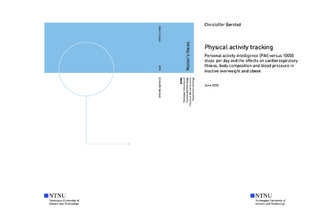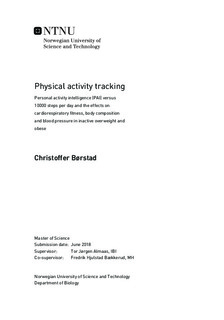| dc.description.abstract | Increased amounts of sedentary time, and less physical activity (PA) have become a global concern, and may result in increased risk of cardiovascular disease (CVD). Thus, it has become an important task to increase PA in the general population. Personal activity intelligence (PAI) is a new metric for activity tracking that takes into account age, sex, resting and maximum heart rate (HR), and give an individualised goal for PA. 100 PAI per week has been found to reduce the risk of CVD and all-cause mortality in epidemiological studies, but the link through increased cardiorespiratory fitness (CRF) has not been established in a controlled clinical trial. The aim of this study was to investigate the effects of following the advice of maintaining 100 PAI per week compared to the effects of walking 10 000 steps daily on CRF, blood pressure (BP) and body composition.
21 obese or overweight men (n=8) and woman (n=13) were randomized to either of two groups; (i) The PAI group (n=10) followed the advice of maintaining a score of 100 PAI for 8 weeks (ii) The step group (n=11) followed the advice of walking 10 000 steps per day. VO2max directly measured with cardiopulmonary exercise testing (CPET), body composition measured with bioelectrical impedance analysis (BIA) and blood pressure (BP), was measured pre- and post-intervention. Analysis of covariance (ANCOVA) was used for comparison between the two groups, and Wilcoxon signed-rank test was used for within group analysis.
Results: No significant differences were found between the two groups.
A negative association between mean weekly PAI and increase in absolute maximum oxygen uptake (VO2max) was found (r = -0.712, p=0.031), and a moderate non-significant positive association was found between mean daily steps and increase in absolute VO2max. A significant median increase (p=0.009) in median VO2max relative to body weight was found in the step group, while a non-significant median increase (p=0.051) was found in the PAI group. The largest mean and absolute increase in VO2max was found in the PAI group. Median BF% was significantly (p=0.028) reduced in the PAI group, and median body weight was significantly (p=0.047) reduced in the step group. No significant change in BP was found within the groups.
Participants in both groups improved PA from pre- to post-intervention. Neither of the groups increased median absolute VO2max significantly, and there was no statistically significant evidence that either of the interventions was superior. The increase in relative VO2max is probably explained by decreased body weight. However, a trend towards a large mean increase in CRF was observed in the PAI group. Future randomized controlled clinical trials may use data obtained in this study for sample size estimations. | en |

